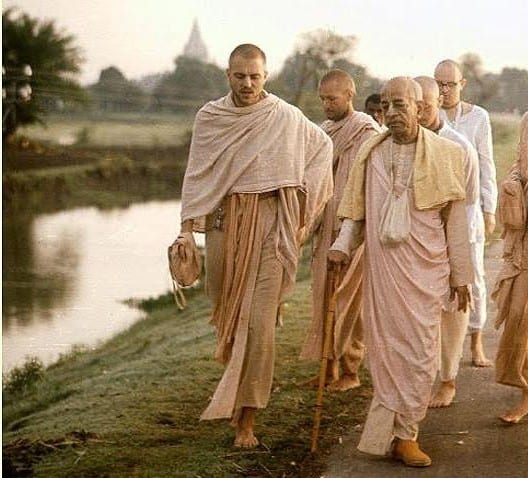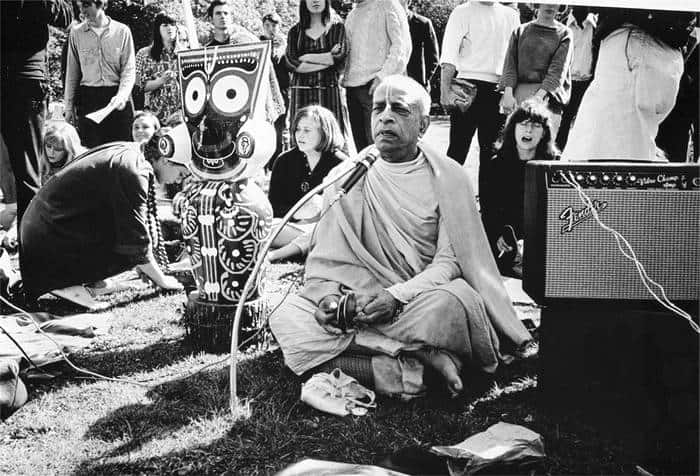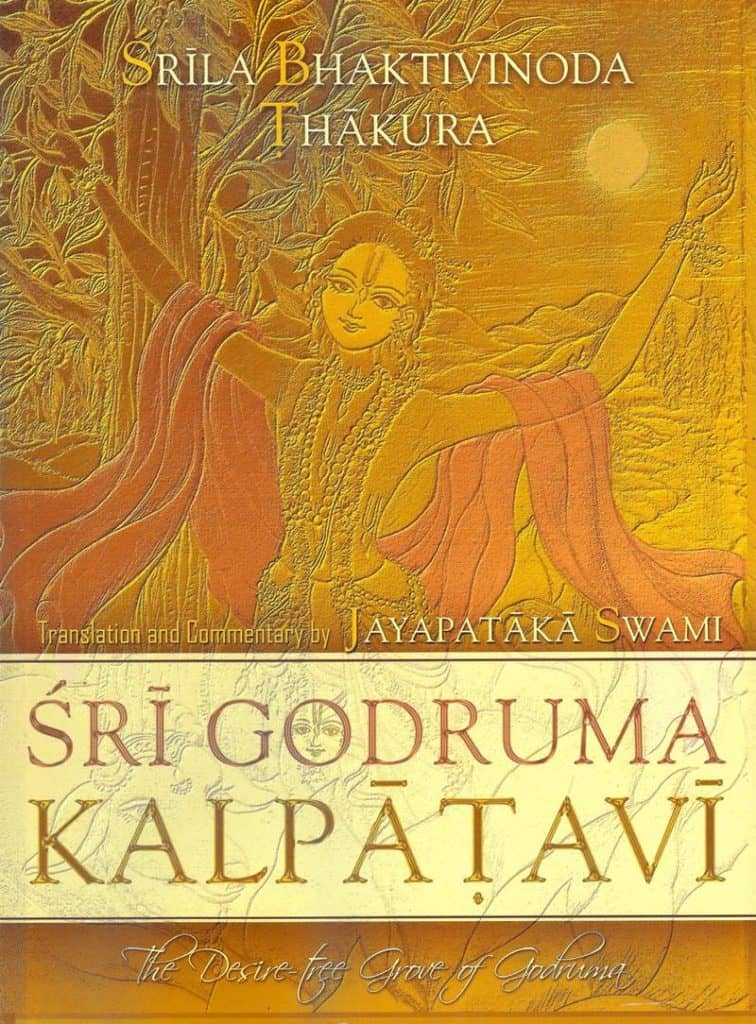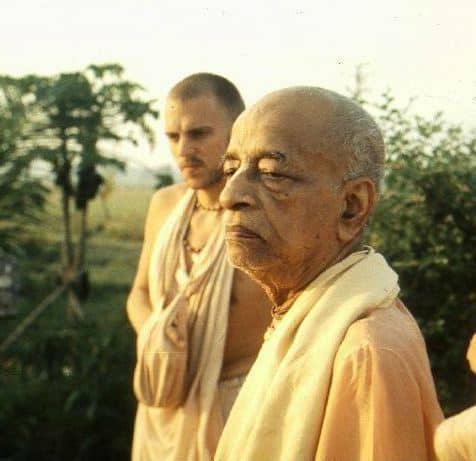Nama-hatta in ISKCON
Presented by Bhakti Raghava Swami, August 18, 2009
This year ISKCON proudly celebrates the 30th anniversary of Nama-hatta. References to the goal and preaching spirit of Nama-hatta can be traced back to the time of Sri Caitanya Mahaprabhu as recorded in the Caitanya Bhagavata where the Lord’s famous order is given to His pioneering preachers Sri Nityananda Prabhu and Sri Haridas Thakura:
suno suno nityananda, suno haridasa,
sarvatra amara ajna koroha prakasa,
prati ghare ghare giya koro ei bhiksa,
bolo krishna, bhaja krishna, koro krishna siksa
“O hear Me, hear Me Nityananda! Hear Me Haridasa! Simply disseminate My order everywhere. Go from house to house and beg [the residents as follows]: ‘Speak about Krsna, worship Krsna and teach [others] about Krsna.'” [Caitanya-bhagavata Madhya-Lila 13.8-9]
Just a few hundred years after the manifest pastimes of Lord Caitanya Mahaprabhu, the great Acarya Srila Bhaktivinoda Thakura again took up the preaching mission of the Lord and recorded the following words in reference to the Nama-hatta preaching work:
boro sukher khabor gai
surabhi-kunjete namer hat khule’che / khoda nita
“I am singing news of the greatest happiness! At the place known as Surabhi Kunja in Shri Navadvipa, the Marketplace of the Holy Name has now been opened-and Lord Nityananda Himself is the Proprietor.” [Vaisnava-Siddhanta-Mala]
By the mercy of Lord Caitanya Mahaprabhu and by the mercy of Srila Prabhupada, the same preaching spirit meant to help inundate the entire world with the Hari Nama Sankirtan Movement of Lord Caitanya has also been introduced in the form of the Nama-hatta program by the devotees serving at Sri Dham Mayapur under the guidance and inspiration of His Holiness Jayapataka Maharaja.
The First Nama-hatta Sangha
The Nama-hatta program officially started in the month of September 1979 in Sri Dham Mayapur. At that time, a group of enthusiastic villagers living near the Mayapur Chandradoya Mandir filled in their Nama-hatta Application Form and officially became the first registered Nama-hatta Sangha. Earlier that year, His Holiness Jayapataka Maharaja had held a meeting with some devotees serving in Sri Mayapur regarding introducing the Nama-hatta program originally set up by Srila Bhaktivinoda Thakura as outlined in his Godruma Kalpatavi. The small book was less known to most devotees since it had not yet been translated from its original Bengali text. I had been serving as the New Bhakta Director for about one year and when invited to attend the meeting I showed interest to become involved, somehow getting a small glimpse of the program’s large potential.
Humble Beginnings
The Nama-hatta activities started on a very small scale with only a handful of devotees and with very little facilities. The only rooms which could be made available at that time were located in the basement of the Cakra Building, referred to then as the “long building”. I chose the last two rooms to the extreme east side of the building, making one as my office and the other as my residence. We had no budget for the Nama-hatta program and no source of income as well.
The program was initially separate from the temple management and was mainly financed by Jaya Pataka Maharaja. In those early days, and until I continued to serve in Sri Mayapur up until 1986, we had no computers, no cell phones, no cameras and no vehicles, only a couple of bicycles. As the program expanded, we required more and more space which was gradually made available in the basement of the “long building”. The number of preachers joining the Nama-hatta Department also gradually increased. For many years the Nama-hatta office remained located in the basement of the long building, somewhat hidden and less known to the general public.
Nama-hatta Misunderstood
In its initial stages of development, the Nama-hatta program could not be so easily understood or sometimes appreciated by many devotees because it involved mostly devotees living outside our temple. It was somewhat of a struggle to get the general temple devotees and even the administration to accept the program. I was initially given the title “Nama-hatta Governing Director” which was changed shortly to “Nama-hatta Regional Director”, a less threatening title.
When we decided to hold the first Nam Hatta Sammelon in the year 1980, something that became a yearly affair attracting thousands of Nama-hatta devotees, the Mayapur Administration had a little difficulty relating to the event because the program was organized somewhat independent from the temple. Here I was as the Regional Director of Nama-hatta inviting the Temple President to our function, in his temple. But gradually, by Lord Caitanya’s mercy and that of the devotees, the program became more integrated and accepted by more and more people. I remember setting up a book table during the yearly seminars held during the Gaura Purnima Festival in Sri Dham Mayapur; very few foreign devotees could relate to the Nama-hatta program.
Nama-hatta Sammelons
To bring the Nama-hatta members closer together and to enthuse them in their preaching work, as well as to increase the number of new Nama-hatta Sanghas, the Nama-hatta Office organized a yearly Sammelon. This generally took place just before or after the Vyasapuja of His Holiness Jayapataka Maharaja. It was a big event drawing Nama-hatta groups from remote villages mainly of W. Bengal and Orissa. They would all converge to Sri Mayapur each bringing their colorful Nama-hatta banners proudly displaying the name of their village and district. Various awards and prizes such as mrdangas, karatals, Deity paraphernalia, books, etc., were given as incentives to those Nama-hatta Sanghas showing the best performances in their sadhana practices and preaching efforts.
Pioneering Devotees
Two of the earlier pioneers to the Nama-hatta program were Gauranga Prema Prabhu, who later became His Holiness Gauranga Prema Maharaja and now heads up the Nama-hatta Department and Gaura Chandra Prabhu, who is presently the most senior preacher of Nama-hatta assisting His Holiness Gauranga Prema Maharaja. Gaura Chandra Prabhu came from the District of Balasore in the Province of Orissa. He was barely 16 years of age when he arrived in Sri Mayapur to join as a full-time devotee and soon after as a full-time preacher under the Nama-hatta Department. Both these devotees have now been connected with the program for close to 30 years and remain the main inspirational leaders. Other pioneers from W. Bengal included Svetadwipa Prabhu, Braja Raja Prabhu, and Koladwipa Prabhu, along with many other preachers.
Enthusiastic “Dadu”
One of the most enthusiastic devotees involved in the Nama-hatta program was “Dadu”. When I was still the New Bhakti Director in Sri Mayapur, one day an old man with long matted hair appeared in my office. He was around 80 years old and had been living in a cave for many years somewhere in Assam. Somehow, by the mercy of some traveling preachers, he had received a Back to Godhead magazine. Soon after reading the magazine he came to Sri Mayapur with the idea of joining as a full-time devotee. We didn’t really know what to make of him because he was already quite old and all our new bhaktas were quite young. He must have been wearing his matted hair for decades because when undone it touched the floor. For the first night at the temple he decided to sleep on the floor in the hallway of the long building. The next day we had more serious discussions with him about how it may be somewhat difficult for him to become a full-time devotee at his age. Seeing his strong determination to join as a full-time devotee we told him that he had to cut off his long matted hair. He immediately proceeded to the Ganga close-by and shaved off his long hair thus joining as a full-time devotee. Soon after becoming a full-time devotee he joined the Nama-hatta preaching programs. He would attend the Nama-hatta function in local villages and very enthusiastically stand on the stage and encourage everyone to chant the holy names.
Pioneering Days
In the beginning, the Nama-hatta devotees had to manage with but few facilities. The devotees would travel by public transport (bus, train, boat, bullock cart and walking) to different parts of W. Bengal, Orissa, and Assam. As soon as we started to register Nama-hatta Sanghas, more and more village people came to know about the program and often people would show up at the Nama-hatta office wanting to become registered.
The registration procedure was very simple. The registration fee was nominal and the regulations to follow were also kept to a minimum. At least five people of the same village were needed to register as a Nama-hatta Sangha. To qualify as a registered Nam Hatta Sangha they agreed to meet once a week in their village and to hold Harinam as well as hear from Sastra. Members were encouraged to chant a few rounds of japa and whenever possible to visit Sri Dham Mayapur. So it was very simple. Whenever possible we would also visit their village. For me, it was very inspiring to see so many people take to the practice of devotional service. Within the first few years, we had actually registered over 1000 Nama-hatta Sanghas.
The Samskar Patra
One of the attractive and innovative methods introduced by Jayapataka Maharaja to connect more people to the Nama-hatta preaching was the “Samskar Patra”, an official Nama-hatta “Oath Card” whereby one would pledge to chant at least one round of the Hare Krsna maha-mantra every day. Dozens, sometimes even hundreds, of enthusiastic participants attending the pandal programs would line up after each program and would promise to chant at least one round of the Maha-mantra. Some people would keep this card with them for years and years proudly showing it to our preachers when coming to the temple, still remember the day when they received their Samskar Patra.
North Bengal Tour and the German Bus
Every year an annual tour was organized in various parts of W. Bengal at which time Jayapataka Maharaja would travel on his own special German-made bus and entourage of devotees. The bus had an inbuilt bed inside so that Maharaja could stay comfortably as in many places the facilities were not always present. The bus also enabled Maharaja to work on his computer which he carried during his preaching tours. This annual North Bengal tour helped to make many devotees and thus boosted the preaching activities of Nama-hatta considerably. It was during these tours that large pandal programs would be organized attracting thousands of curious on-lookers. To arrange these tours required quite a bit of planning, most of which was done by our Bengali preachers traveling ahead to make such arrangements. As the Nama-hatta members became more familiar with the tours, they themselves made all the arrangements for staying and for prasadam. At times up to 50 devotees or more would be traveling with Jayapataka Maharaja on these tours.
To drive this German bus, foreign devotees with good driving records were selected. Once the regular bus driver for Jayapataka Maharaja fell ill and could not drive his bus. I offered to drive the bus although I had not driven such a big bus before. When I was in Canada I had previously obtained my chauffer’s license which allows one to drive various vehicles. So for quite a few days, I became Maharaja’s official driver. I was pleased to hear Maharaja comment after the tour that my driving was quite smooth compared to some of the previous drivers.
Preaching with His Holiness Jayapataka Maharaja
His Holiness Jayapataka Maharaja took upon himself many great austerities to establish and promote the Nama-hatta program, from its early inception to its present-day development. I remember how he would sometimes arrive from overseas and from the airport he would have to dash to the Howrah station in Calcutta to catch a night train which would take him to some remote village where programs had already been scheduled. He would make his way to the local pandal, sometimes using his own small flashlight as no one had thought of getting a proper torch or lantern. In those early days, the arrangements in the village were quite simple and somewhat humble in nature. Still, Maharaja was always ready to accept any and all inconveniences to hold programs and preach in the local Bengali language to the local eager listeners.
Because of on-going responsibilities in other parts of the world, whenever Jayapataka Maharaja would travel on these tours, he would have to keep up with his communication so he would travel with his computer. Devotees had to arrange for an electric connection to ensure that his computer could endure passing the limited time of batteries in those earlier days (he generally had one additional battery for his computer but he probably needed more that one). He would often work late in the evening to finish off some important reports or catch up on e-mail communication. The electric wires would be coming to his bus and in this way, his work could continue. I am sure it happened on more than one occasion but I personally saw how, on one occasion, some of the local village people, not conscious of the computer work going on inside the bus, would not be cautious in walking around the bus and accidentally caused the lines to become disconnected. Maharaja was sometimes a bit in despair having lost a lot of unsaved material.
Jayapataka Maharaja was always very caring to all the devotees, including myself. Once when returning to India from a preaching tour outside of India, knowing that the working conditions in the Nama-hatta basement office were not so ideal, he came to the office and presented me with a brand new electric wall fan which he had carried all the way from some foreign country to India. I very much appreciated the gesture.
Nama-hatta Today
Today the Nama-hatta program has developed very widely having its own ministry called ISKCON Congregational Ministry with His Holiness Jayapataka Maharaja as the Global Minister and Kaunteya Prabhu as the Director. The Nama-hatta devotees in Sri Dham Mayapur now have a large building to accommodate the thousands of Nama-hatta members who visit the holy Dham every year and to coordinate the many activities of their department. There are close to 100 brahmacary devotees divided into several groups covering various parts of W. Bengal and Orissa. A number of buses are now available to serve the Nama-hatta mission. Thus, by the mercy of the previous Acaryas and the determined efforts of today’s Nama-hatta preachers, the prediction of Lord Caitanya Mahaprabhu is gradually coming to past with the spreading of the holy names in every town and village.
Nam Hatta and the Future
Those who joined the Hare Krsna Movement in the days when Srila Prabhupada was himself present recall how our conception of who is a devotee has evolved over the years from a somewhat narrow and exclusive understanding to a wider and more inclusive one. For example, in the early days, if one was not living in the temple he was considered in Maya. In a similar way, if someone was not shaved up and wearing a sikha, he was also considered in Maya. We have gradually matured and have been able to encompass and embrace as devotees those who lived outside our temples working in some profession. From our immediate congregation of devotees closely connected with the temple grew the acceptance of those who were living far from our temples like the Nama-hatta members.
When I was involved with the Nama-hatta preaching program, I could sense the initial reluctance on the part of many devotees in accepting Nama-hatta devotees as being very much part of Lord Caitanya’s movement. This same resistance is now manifest in another form when considering yet another major area of Srila Prabhupada’s overall vision, the varnasrama mission. This is of special importance to the Nama-hatta preaching work. It can only be easily understood if we become familiar with the expressed desires of Srila Prabhupada for spreading Krsna consciousness to the wider society, what Srila Prabhupada termed as “large-scale” preaching. These instructions and this vision of Srila Prabhupada are given in his essay called Conception of Gita Nagari written in the 1956 Back to Godhead Magazine.
Nama-hatta and the Varnasrama Mission
Srila Prabhupada outlined four major phases for the overall preaching movement of Lord Caitanya to which he gave specific names. He has coined the first phase as the “Sankirtan Movement” referring to the spreading of the holy names and the large-scale distribution of books. He called the second phase as the “Temple Worship Movement” referring to establishing temples and installing Deities. He referred to the third phase as the “Spiritual Initiation Movement” referring to congregational preaching, of which Nama-hatta has been the foremost program. All these three phases continue to be major areas of development within our ISKCON society. However, the fourth phase referred to by Srila Prabhupada as the “Classless Society Movement” (the varnasrama mission) is yet to unfold as it should. All these four phases are meant to support and complement one another. All of them have a bright future if we make the proper connection and give all four the support needed.
Varnasrama Colleges
To facilitate all four movements to happen Srila Prabhupada requested all centers to establish Varnasrama Colleges.
“The varnasrama college has to be established immediately. Everywhere, wherever we have got our center, a varnasrama college should be established to train four divisions: one class, brahmana; one class, ksatriya; one class, vaisya; and one class, sudra. But everyone will be elevated to the spiritual platform by the spiritual activities which we have prescribed. There is no inconvenience, even for the sudras.” [Morning Walk, March 12, 1974, Vrindavana]
The devotee educated youth, as well as our own second generation youth members, have an important role to play in promoting both the Nama-hatta and Varnasrama Mission.
Srila Narada Muni, in his most important instructions on varnasrama (SB Canto VII, Chapters 11 to 15) explains how those who will develop the expected 30 qualities of human beings are the best candidates to help establish the varnasrama mission. Nama-hatta is therefore meant to play a vital role in helping this fourth phase one day become a reality, thus fulfilling to an ever larger extent the overall Sankirtan mission of Lord Caitanya Mahaprabhu which is meant to bring a total overhaul to contemporary society.
The Vision of our Acaryas
The mission of Lord Caitanya can best be understood by studying what our previous Acaryas have written. Our foremost Acaryas can be found in the persons of Srila Bhaktivinoda Thakura, Srila Bhaktisiddanta Sarasvati Thakura and Srila Prabhupada , the Founder-Acarya of our ISKCON society.
Srila Bhaktivinoda Thakura
“With the assistance of varnasrama dharma, a person should cultivate bhakti. It is also necessary to follow the rules of varnasrama in the cultivation of bhakti.” [From “Sri Caitanya Siksamrta, Chapter 3]
“Though all humans have a right to practice bhakti, those who follow the regulations of varnasrama have a much easier time.” [From “Sri Caitanya Siksamrta, Chapter 3]
“People of this world who are proud of their own aristocratic birth cannot attain real aristocracy. Therefore they attack the pure Vaisnavas, saying, “They have taken birth in low-class families because of their sins.” Thus they commit offenses. The solution to this problem is to establish the order of daivi-varnasrama dharma – something you have started doing; you should know that to be the real service to the Vaisnavas… [Letter ‘Sarasvati’]
The real service to Sri Mayapur can be done by acquiring printing presses, distributing devotional books, and preaching congregational chanting, not reclusive bhajan. Please do not neglect to serve Sri Mayapur or to preach for the sake of your own reclusive bhajan. [Letter ‘Sarasvati’]
I had a special desire to preach the significance of such books as Srimad-Bhagavatam, Sat Sandarbha, and Vedanta Darsan. You have to accept that responsibility. Sri Mayapur will prosper if you establish an educational institution there. [Letter ‘Sarasvati’]
Srila Prabhupada
“Unless in the human society the varnasrama system is introduced, no scheme or social order, health order or any order, political order, will be successful”. [Room Conversation, October 18, 1977, Vrndavana]
Prabhupada: Yes. In the… For the big scale, this is the required. In big scale, you cannot make all of them as brahmanas or sannyasis. No. That is not possible. This is a small scale. How many percentages of people of the world we are controlling? Very insignificant. But if you want to make the whole human society perfect, then this Krsna consciousness movement should be introduced according to Krsna’s instruction, if you want to do it in a large scale for the benefit of the whole human society. Now we are picking up some of them, best. That is another thing. But Caitanya Mahäprabhu said para-upakara. Why should a certain section be picked up? The whole mass of people will get the benefit of it. Then it is required, systematic. Sve sve karmany abhiratah samsiddhim labhate narah. Para-upakara means mass benefit, not there is a certain section. Then we have to introduce this varnasrama-dharma. It must be done perfectly, and it is possible and people will be happy. [Conversations, February, 1977, Sri Mayapura]
CONCLUSION
On the occasion of this 30th anniversary of Nama-hatta in Sri Mayapur and around the world, I pray that Their Lordships Sri Sri Radha Madhava may kindly inspire all the preachers of Nama-hatta to continue in their enthusiastic preaching work. The predictions of the Acaryas are slowly coming to be. Nama-hatta will continue to serve the mission of both Srila Prabhupada and that of Lord Caitanya Mahaprabhu in more and more illustrious ways. Hare Krsna.




